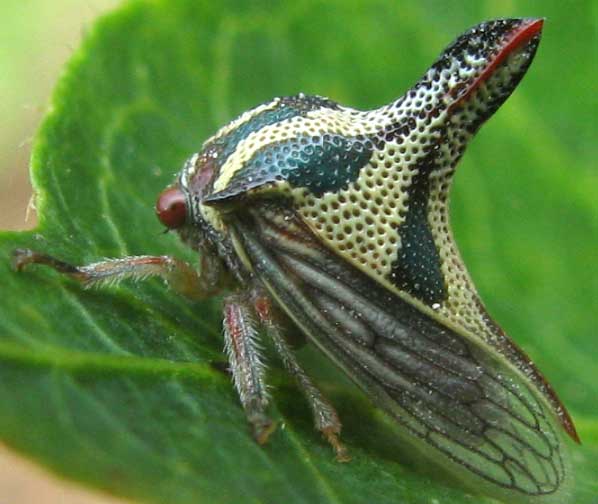Excerpts from Jim Conrad's
Naturalist Newsletter

from the January 1, 2012 Newsletter issued from Hacienda Chichen Resort beside Chichén Itzá Ruins; limestone bedrock; elevation ~39m (~128ft), N20.675°, W88.569°; central Yucatán state, MÉXICO
RARE TREEHOPPER
The other day a pea-size insect turned up on a Chaya leaf right beside me as I read a book. That's him above. That's one of the prettiest and most bizarrely ornamented organisms I've seen in a long time. Still, there's something familiar about the critter despite his psychedelic, spiky covering. With those oversized, widely spaced, goggly compound-eyes and long, backwardly swept wings, he's reminiscent of a cicada or aphid. That makes sense because he belongs to the cicada/aphid "order," the Homoptera.
This is a treehopper, which I know because in many other places, all my life, I've been running into many treehopper kinds. And one thing I know about treehoppers is that they're likely to turn up with surprising shapes and patterns, and wearing gaudy colors.
In fact, you might enjoy doing a search-engine image search on the keyword "treehopper," and just look at the rainbow of treehopper types turning up in the thumbnails. Many treehoppers protect themselves with "disruptive patterning," like a soldier's camouflage uniform with its random splotches breaking up the body's contour lines. Others employ bright colors, taking advantage of a predator's notion that "Anything this garishly colored must be dangerous." Many bear spines causing them to look plant thorns. I can't imagine, though, the prime motive behind our treehopper's zebra-lined, honeycombed, spiny look.
Actually, I "keyed out" to some species very similar to ours, in the family Membracidae, but I never did get an exact match. If you have better luck than I, let me know.